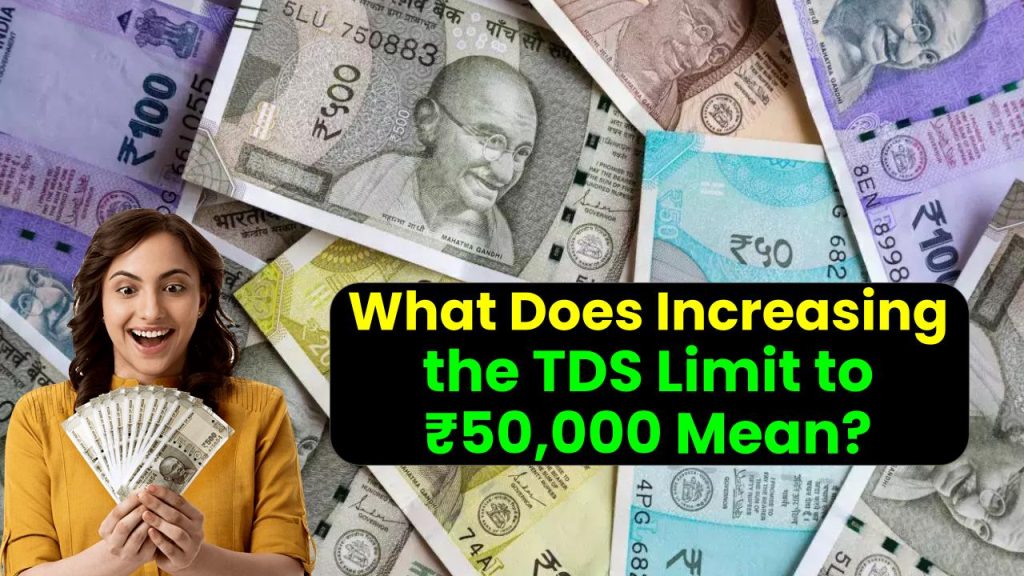
If you have a Fixed Deposit (FD) or are planning to invest in one, there’s some good news starting April 1, 2025. The Indian government has officially increased the TDS (Tax Deducted at Source) threshold on interest earned from bank deposits. The new rule raises the limit from ₹40,000 to ₹50,000 for regular taxpayers and from ₹50,000 to ₹1,00,000 for senior citizens. This change means you can now earn more interest without facing TDS deduction — giving more power to your savings.
More Benefits on FD from Today
| Point | Details |
|---|---|
| Effective Date | April 1, 2025 |
| Old TDS Threshold (Non-Senior Citizens) | ₹40,000/year |
| New TDS Threshold (Non-Senior Citizens) | ₹50,000/year |
| Senior Citizen TDS Threshold | Increased from ₹50,000 to ₹1,00,000/year |
| Applicable On | FD, RD, and other interest-earning bank deposits |
The government’s move to raise the TDS limit on FD interest to ₹50,000 and ₹1 lakh for senior citizens is a welcome relief. It ensures that more people can earn without automatic tax deductions, allowing better financial planning and smoother cash flow.
That said, it’s important to remember that TDS exemption doesn’t mean total tax exemption. Always report your interest income in your ITR and consult a financial advisor if you’re unsure.
What Is TDS on FD Interest?
TDS, or Tax Deducted at Source, is a way for the government to collect tax at the time the income is earned rather than at a later date. When you earn interest on Fixed Deposits, banks are required to deduct a portion of that income as TDS if it crosses a specific threshold in a financial year.
Previously, if your FD interest crossed ₹40,000 (or ₹50,000 for senior citizens), the bank would deduct 10% TDS before crediting the remaining interest to your account. With the new rule from April 1, 2025, the limit has now been raised to ₹50,000 for general depositors and ₹1,00,000 for senior citizens.
see also: If You Break a 5-Year FD Before Maturity, You Will Face a Double Blow
Why This Matters: Benefits for FD Investors
This move significantly benefits small and medium depositors, especially retirees who rely on fixed income.
1. Higher Interest Earnings Without Deduction
If your annual FD interest is below the new limits, no TDS will be deducted. This gives you full access to your interest earnings, improving liquidity.
Example: If you invest ₹7 lakh at 7% interest in a bank FD, you earn ₹61,000 annually. Under the previous limit (₹40,000), TDS would apply. But now, you’re within the ₹50,000 limit, and no TDS will be deducted.
2. Reduced Paperwork and Compliance
With the increased threshold, many investors no longer need to submit Form 15G/15H to avoid TDS. This reduces the burden of documentation and yearly follow-ups.
3. More Effective Financial Planning
For senior citizens earning less than ₹1,00,000 in interest annually, this change offers a significant tax relief and helps with smoother retirement planning.
Who Benefits the Most?
Senior Citizens
Under Section 80TTB of the Income Tax Act, senior citizens already get an exemption of up to ₹50,000 on interest from deposits. With the TDS threshold now at ₹1 lakh, they enjoy double benefits:
- No TDS on interest up to ₹1 lakh.
- Tax deduction up to ₹50,000 on the same.
Small Depositors and Low-Income Earners
Those who keep modest FD investments for emergencies or savings now get more returns in hand, without deduction hassles.
Non-Resident Indians (NRIs)
While the TDS threshold may still apply to NRIs differently, this move could reduce TDS deductions if the total interest stays within the new limits.
Important Note: TDS Exemption ≠ Tax Exemption
Just because no TDS is deducted doesn’t mean the interest is tax-free.
You still have to declare it in your ITR and pay tax if your total income crosses the basic exemption limit.
Income Tax Slabs for FY 2025-26:
- Up to ₹2.5 lakh: Nil (for individuals below 60 years)
- Up to ₹3 lakh: Nil (senior citizens)
- Up to ₹5 lakh: Nil (super senior citizens, above 80)
So, if your total income is below these limits, you won’t need to pay tax — but you must still report it.
What If You Still Want to Avoid TDS?
You can still submit Form 15G (below 60 years) or Form 15H (60+ years) if your income is below the taxable limit. These self-declarations tell the bank not to deduct TDS. Submit the form at the beginning of every financial year to ensure no TDS is deducted during the year.
Practical Tips to Maximize Benefits from FD TDS Changes
Tip 1: Ladder Your FDs
Split your total investment into multiple FDs with different maturity dates. This helps avoid a bulk interest payout in one financial year.
Tip 2: Track Interest Income
Use net banking or ask your bank for an annual Interest Certificate to track how much interest you earn in a year.
Tip 3: Choose Tax-Saver FDs
If you want tax deduction benefits, opt for 5-year tax-saver FDs under Section 80C, which allow up to ₹1.5 lakh deduction.
Tip 4: Use Joint FDs Wisely
Interest from joint FDs is taxable in the hands of the first holder. If one account holder has a lower tax liability, make them the first holder.
see also:
Frequently Asked Questions (FAQs)
1. What is the new TDS limit on FD interest?
From April 1, 2025, the TDS limit is ₹50,000 for regular citizens and ₹1,00,000 for senior citizens per financial year.
2. Will I still need to pay tax if my FD interest is below ₹50,000?
You won’t face TDS, but if your total income exceeds the exemption limit, you will have to pay tax while filing ITR.
3. Do I need to submit Form 15G/15H now?
You only need to submit Form 15G/15H if your total income is below taxable limits. Otherwise, it’s not required just to avoid TDS.
4. Is TDS applicable on recurring deposits (RD) too?
Yes. TDS rules apply to RD interest as well, just like FDs.
5. Where can I check my total interest income?
You can check via net banking, your bank passbook, or request an annual interest certificate from your bank.











